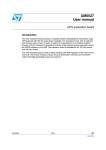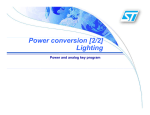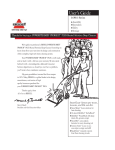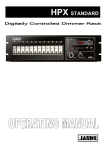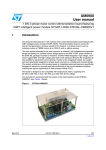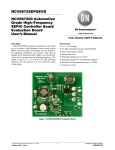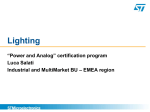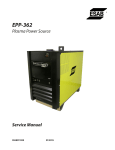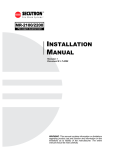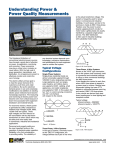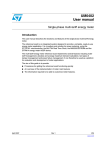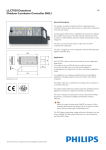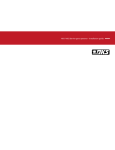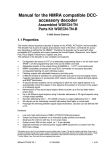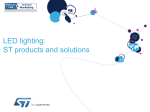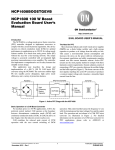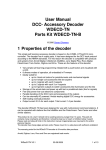Download STEVAL-ILL019V1 offline RGGB LED driver demonstration board
Transcript
UM0926 User manual STEVAL-ILL019V1 offline RGGB LED driver demonstration board with high PF Introduction The STEVAL-ILL019V1 demonstration board was developed to drive high brightness and power RGGB LEDs used in many different lighting applications. Thanks to RGGB LEDs, it is possible to easily modify the color of the light, change the brightness level, implement additional lighting features such as automatic color changes or a blinking mode, improve lighting efficiency compared to standard lighting products and finally also achieve significant energy savings. Typically, RGGB LED applications can be found as decorative lighting in houses or hotels, as architectural lighting in stadiums, historic buildings, bridges and monuments, as wall washing, shop lighting and in many other special lighting applications. The STEVAL-ILL019V1 implements an innovative solution for driving multiple color RGGB LEDs, where high Power Factor, safety isolation and individual regulation of LED brightness are required. A constant current is set to 350 mA. Thanks to the microcontroller onboard, the output channels are independently controlled by four PWM signals, allowing the application users to set any color of the light or create automatic color effects. The demonstration board is shown in Figure 1 and its ordering code is STEVAL-ILL019V1. STEVAL-ILL019V1 main features ■ Constant LED current: 350 mA ■ 4 channels for RGGB LEDs designed on the board ■ Line input voltage range: 88 V to 265 V AC ■ Load: 5 to 13 LEDs per each channel ■ 32 W maximum RGGB LED power (wide input voltage range) ■ 42 W maximum RGGB LED power (EU input voltage range) ■ Isolated SMPS ■ Individual regulation of RGGB brightness ■ EN55015 and EN61000-3-2 compliant ■ Double-sided PCB, 145 mm x 75 mm x 27 mm Figure 1. October 2010 STEVAL-ILL019V1 demonstration board Doc ID 17274 Rev 1 1/25 www.st.com www.BDTIC.com/ST Contents UM0926 Contents 1 Getting started with the STEVAL-ILL019V1 . . . . . . . . . . . . . . . . . . . . . . 5 1.1 Automatic color change mode . . . . . . . . . . . . . . . . . . . . . . . . . . . . . . . . . . 5 1.2 Manual color change mode . . . . . . . . . . . . . . . . . . . . . . . . . . . . . . . . . . . . 6 2 Design concept . . . . . . . . . . . . . . . . . . . . . . . . . . . . . . . . . . . . . . . . . . . . . 7 3 STEVAL-ILL019V1 measurements . . . . . . . . . . . . . . . . . . . . . . . . . . . . . . 8 3.1 PF, THD efficiency . . . . . . . . . . . . . . . . . . . . . . . . . . . . . . . . . . . . . . . . . . . 8 3.2 Output current for different number of LEDs . . . . . . . . . . . . . . . . . . . . . . 10 3.3 Maximum load capability . . . . . . . . . . . . . . . . . . . . . . . . . . . . . . . . . . . . . 11 3.4 Dimming . . . . . . . . . . . . . . . . . . . . . . . . . . . . . . . . . . . . . . . . . . . . . . . . . . 13 3.5 Input and output electrical waveforms . . . . . . . . . . . . . . . . . . . . . . . . . . . 13 3.6 Thermal measurement . . . . . . . . . . . . . . . . . . . . . . . . . . . . . . . . . . . . . . . 14 3.7 Standard EN61000-3-2 measurement . . . . . . . . . . . . . . . . . . . . . . . . . . . 15 3.8 EMI measurement (EN55015) . . . . . . . . . . . . . . . . . . . . . . . . . . . . . . . . . 16 4 Power transformer specifications . . . . . . . . . . . . . . . . . . . . . . . . . . . . . 17 5 Schematic diagrams . . . . . . . . . . . . . . . . . . . . . . . . . . . . . . . . . . . . . . . . 19 6 Bill of material . . . . . . . . . . . . . . . . . . . . . . . . . . . . . . . . . . . . . . . . . . . . . 21 7 References . . . . . . . . . . . . . . . . . . . . . . . . . . . . . . . . . . . . . . . . . . . . . . . . 24 8 Revision history . . . . . . . . . . . . . . . . . . . . . . . . . . . . . . . . . . . . . . . . . . . 24 2/25 Doc ID 17274 Rev 1 www.BDTIC.com/ST UM0926 List of tables List of tables Table 1. Table 2. Table 3. Table 4. LED current vs. number of LEDs . . . . . . . . . . . . . . . . . . . . . . . . . . . . . . . . . . . . . . . . . . . . 11 Transformer design specifications . . . . . . . . . . . . . . . . . . . . . . . . . . . . . . . . . . . . . . . . . . . 18 Bill of material - STEVAL-ILL019V1 . . . . . . . . . . . . . . . . . . . . . . . . . . . . . . . . . . . . . . . . . . 21 Document revision history . . . . . . . . . . . . . . . . . . . . . . . . . . . . . . . . . . . . . . . . . . . . . . . . . 24 Doc ID 17274 Rev 1 www.BDTIC.com/ST 3/25 List of figures UM0926 List of figures Figure 1. Figure 2. Figure 3. Figure 4. Figure 5. Figure 6. Figure 7. Figure 8. Figure 9. Figure 10. Figure 11. Figure 12. Figure 13. Figure 14. Figure 15. Figure 16. Figure 17. Figure 18. Figure 19. Figure 20. Figure 21. Figure 22. Figure 23. Figure 24. Figure 25. Figure 26. Figure 27. Figure 28. Figure 29. Figure 30. 4/25 STEVAL-ILL019V1 demonstration board . . . . . . . . . . . . . . . . . . . . . . . . . . . . . . . . . . . . . . . 1 Default RGGB LED load used for testing . . . . . . . . . . . . . . . . . . . . . . . . . . . . . . . . . . . . . . . 5 J3 connector with manual control circuitry . . . . . . . . . . . . . . . . . . . . . . . . . . . . . . . . . . . . . . 6 Different color settings using manual color control . . . . . . . . . . . . . . . . . . . . . . . . . . . . . . . . 6 STEVAL-ILL019V1 block diagram . . . . . . . . . . . . . . . . . . . . . . . . . . . . . . . . . . . . . . . . . . . . 7 STEVAL-ILL019V1 demonstration board used for measurements. . . . . . . . . . . . . . . . . . . . 8 Power Factor measurement . . . . . . . . . . . . . . . . . . . . . . . . . . . . . . . . . . . . . . . . . . . . . . . . . 9 Power Factor - zoom measurement . . . . . . . . . . . . . . . . . . . . . . . . . . . . . . . . . . . . . . . . . . . 9 Total Harmonic Distortion (THD) measurement . . . . . . . . . . . . . . . . . . . . . . . . . . . . . . . . . 10 Efficiency measurement . . . . . . . . . . . . . . . . . . . . . . . . . . . . . . . . . . . . . . . . . . . . . . . . . . . 10 Modified buck converter output current . . . . . . . . . . . . . . . . . . . . . . . . . . . . . . . . . . . . . . . 11 High PF flyback converter power capability for VIN = 88 V AC . . . . . . . . . . . . . . . . . . . . . . 12 High PF flyback converter power capability for VIN = 185 V AC . . . . . . . . . . . . . . . . . . . . . 12 PWM dimming 50% . . . . . . . . . . . . . . . . . . . . . . . . . . . . . . . . . . . . . . . . . . . . . . . . . . . . . . 13 PWM dimming 10% . . . . . . . . . . . . . . . . . . . . . . . . . . . . . . . . . . . . . . . . . . . . . . . . . . . . . . 13 PWM dimming 1% . . . . . . . . . . . . . . . . . . . . . . . . . . . . . . . . . . . . . . . . . . . . . . . . . . . . . . . 13 PWM dimming 1% - zoom . . . . . . . . . . . . . . . . . . . . . . . . . . . . . . . . . . . . . . . . . . . . . . . . . 13 LED current measurement . . . . . . . . . . . . . . . . . . . . . . . . . . . . . . . . . . . . . . . . . . . . . . . . . 14 Input voltage and current waveforms for VIN = 110 V AC. . . . . . . . . . . . . . . . . . . . . . . . . . 14 Input voltage and current waveforms for VIN = 230 V AC. . . . . . . . . . . . . . . . . . . . . . . . . . 14 Thermal measurement on the STEVAL-ILL019V1 . . . . . . . . . . . . . . . . . . . . . . . . . . . . . . . 15 EN61000-3-2 compliance for input voltage 110 V AC . . . . . . . . . . . . . . . . . . . . . . . . . . . . 16 EN61000-3-2 compliance for input voltage 230 V AC . . . . . . . . . . . . . . . . . . . . . . . . . . . . 16 Quasi-peak measurement from 9 KHz to 30 MHz . . . . . . . . . . . . . . . . . . . . . . . . . . . . . . . 16 Average measurement from 150 KHz to 30 MHz . . . . . . . . . . . . . . . . . . . . . . . . . . . . . . . . 16 Transformer frame dimensions . . . . . . . . . . . . . . . . . . . . . . . . . . . . . . . . . . . . . . . . . . . . . . 17 Transformer winding description. . . . . . . . . . . . . . . . . . . . . . . . . . . . . . . . . . . . . . . . . . . . . 18 Winding position on the transformer . . . . . . . . . . . . . . . . . . . . . . . . . . . . . . . . . . . . . . . . . . 18 High PF flyback converter . . . . . . . . . . . . . . . . . . . . . . . . . . . . . . . . . . . . . . . . . . . . . . . . . 19 Four modified buck converters and microcontroller . . . . . . . . . . . . . . . . . . . . . . . . . . . . . . 20 Doc ID 17274 Rev 1 www.BDTIC.com/ST UM0926 1 Getting started with the STEVAL-ILL019V1 Getting started with the STEVAL-ILL019V1 This section allows designers to quickly evaluate the board as the load and external potentiometer connections (to manually control the color of the light) are described. As already stated, the light color can be changed automatically or manually. The application is set by default to automatic mode in case no potentiometer nor jumper is connected to the board via the J3 connector (see Figure 1). In order to control each LED channel manually, the potentiometers and jumper must be connected to the J3 connector. These two modes are demonstrated in the following sections. 1.1 Automatic color change mode First, the RGGB LEDs must be connected to the board via the output connector J6 (see Figure 1). Four independent channels marked as CH1, CH2, CH3 and CH4 allow controlling four independent LED strings. The LED anode must be connected to the plus (+) pin and the LED cathode must be connected to the minus (–) pin, which is marked close to the connector J6. The recommended minimum LED voltage for each channel is 15 V and the maximum voltage is 40 V, in order to keep the LED current within ±5%. As the typical LED forward voltage is 3.5 V, an LED string with 5 to 11 LEDs per channel must be used. The designers must also take into account that the maximum output LED power is 32 W for wide input voltage range (88 V to 265 V AC) and 42 W for EU input voltage range (188 V to 265 V AC). It is also possible to use only one, two or three channels. A typical example of how the load with RGGB LEDs can be designed is shown in Figure 2 which is also the default RGGB LED load used for measurements on the STEVAL-ILL019V1demonstration board. In this case channel 1 has 6 green LEDs, channel 2 has 8 red LEDs, channel 3 has 7 green LEDs and channel 4 has 9 blue LEDs. This RGGB LED load is just for demonstration purposes and is not available for ordering. Figure 2. Default RGGB LED load used for testing Doc ID 17274 Rev 1 www.BDTIC.com/ST 5/25 Getting started with the STEVAL-ILL019V1 UM0926 The last step after the RGGB LED load connection is to supply the demonstration board with the proper input voltage. The output light color is automatically changed as soon as the input voltage is applied to the board via connector J1. 1.2 Manual color change mode First connect the RGGB LED load to the STEVAL-ILL019V1 as described in the previous section. Then connect the potentiometers to the J3 connector as demonstrated in Figure 3. The control connector has three main purposes. Firstly, it is used in manufacturing to connect the programming station and program the ST7 microcontroller. Secondly, it connects up to four potentiometers to set the brightness of each LED string. For the RGGB LED module, only three potentiometers are used because two green LED strings are driven with the same brightness. The last feature on the connector is a “Mode selection Pin 9" which is used to choose either automatic or manual mode. During automatic mode, pin 9 is internally grounded. A positive voltage of 5 V must be connected to pin 9 (for example to use the switch S) for the manual mode. The automatic mode does not require any action from the user and changes the colors through the color spectrum. The manual mode keeps the color stable based on the position of the potentiometers. The last step is to resupply the board with the proper input voltage. The output light color can be manually tuned as demonstrated in Figure 4. The external control circuitry is again used just for demonstration purposes and is not available for ordering. 6/25 Figure 3. J3 connector with manual control circuitry Figure 4. Different color settings using manual color control Doc ID 17274 Rev 1 www.BDTIC.com/ST UM0926 2 Design concept Design concept Figure 5 shows the STEVAL-ILL019V1 block diagram. Basically, the board consists of two converters. The first one is in fact an AC/DC converter designed as an isolated high PF flyback converter using the L6562A controller with the STP7NK80ZFP Power MOSFET as a switch. The input voltage for this convertor can be between 88 V and 265 V AC and the converter delivers up to 35 W for this wide input voltage range. The output voltage is set to 48 V. The high Power Factor flyback convertor was already designed separately for demonstration purposes (ordering code is EVL6562A-35WFLB) and therefore all design equations and calculations are described in AN2838 (see Section 7: References). The second converter is in fact a constant current LED driver. It is a modified buck converter designed as the constant current source recommended for proper LED driving using the L6562A and STS4NF100 Power MOSFETs. Four independent DC/DC converters are assembled on the board in order to drive independent RGGB LED strings. The demonstration board for a modified buck converter was also developed (ordering code is EVL6562A-LED) and this design concept is described in AN2983 (see Section 7: References). All design equations for the modified buck converter are shown in AN2928 (see Section 7: References). The color control and brightness regulation is provided by the PWM generator which has four independent channels. Each PWM signal is connected to one modified buck converter in order to set the required brightness level for each LED string. The PWM signal can be set between 0% and 100% (no brightness or maximum brightness). The ST7FLIT15BF1M6 microcontroller assembled on the board provides the right PWM signals. Thanks to the microcontroller, it is also possible to modify the light effects. The RGGB LED brightness can be set manually, if the external potentiometers are connected to the board via the connector J3. Figure 5. STEVAL-ILL019V1 block diagram ()'(0/7%2&!#4/2&,9"!#+#/.6%24%2 6).6TO 6!# -/$)&)%$"5#+#/.6%24%2#( TO,%$S 6 344(23 3403(! )NPUTFILTER 0&CONTROLLER ,!$ 340.+:&0 343.& 0&CONTROLLER ,!$ #(!..%, #(!..%, 07-'%.%2!4 /2 CHANNELS #(!..%, -ICROCONTROLLER 34&,)4"&- 0 0 0 0 EXTERNALPOTENTIOMETERS FORINDIVIDUALBRIGHTNESS !- Doc ID 17274 Rev 1 www.BDTIC.com/ST 7/25 STEVAL-ILL019V1 measurements 3 UM0926 STEVAL-ILL019V1 measurements The most important parameters such as electrical behavior, thermal behavior, dimming function, board power capability and standards (EN55015 and EN61000-3-2) were measured on the STEVAL-ILL019V1demonstration board shown in Figure 6 and the results are given in the following section. Figure 6. 3.1 STEVAL-ILL019V1 demonstration board used for measurements PF, THD efficiency The power factor (PF) is shown in Figure 7 and Figure 8. Two RGGB LED loads are used for this measurement. Firstly, the default load of 30 W RGGB LEDs (9 blue LEDs, 13 green LEDs and 8 red LEDs) was used for the measurement and this load is shown in Figure 2. The second load used for the measurement is 20 W RGGB LEDs (5 blue LEDs, 8 green LEDs and 7 red LEDs). The power factor is 0.995 for the input voltage 110 V AC and 0.94 for the input voltage 230 V AC (measured for 30 W load). The total harmonic distortion (THD) measurement is demonstrated in Figure 9. THD is 8.5 for the input voltage 110 V AC and 14.1 for the input voltage 230 V AC (measured for 30 W load). The efficiency measurement for these two loads is shown in Figure 10. The efficiency is approximately 75% for a 30 W load, which is in line with the estimation performance because there are two converters (AC/DC and DC/DC) used in the design. 8/25 Doc ID 17274 Rev 1 www.BDTIC.com/ST UM0926 STEVAL-ILL019V1 measurements Figure 7. Power Factor measurement 0OWER&ACTOR;= 0O WER&ACTOR ,%$S ,%$S )NPUTVOLTAGE;6= !- Figure 8. Power Factor - zoom measurement 0OWER&ACTOR;= 0O WER&ACTORZOOM ,%$S ,%$S )NPUTVOLTAGE;6= !- Doc ID 17274 Rev 1 www.BDTIC.com/ST 9/25 STEVAL-ILL019V1 measurements Figure 9. UM0926 Total Harmonic Distortion (THD) measurement 4($;= 4($ ,%$S ,%$S )NPUTVOLTAGE;6= !- Figure 10. Efficiency measurement %FFICIENCY;= %FFICIENCY ,%$S ,%$S )NPUTVOLTAGE;6= !- 3.2 Output current for different number of LEDs Thanks to the modified buck converter designed as the current source (additional feedback resistors R56, R57, R58 and R59 in the design), it is possible to drive a variable number of LEDs. The output constant current was checked for different numbers of LEDs connected to the modified buck converter and the result is demonstrated in Table 1 and Figure 11. It is recommended to have the output voltage between 15 V and 38 V in order to keep the output LED current within approximately ±5%. An established number of LEDs follows the output voltage recommendation and can be easily calculated as the LED forward voltage is a typical parameter written in any LED datasheet. 10/25 Doc ID 17274 Rev 1 www.BDTIC.com/ST UM0926 STEVAL-ILL019V1 measurements Table 1. LED current vs. number of LEDs Number of LEDs 4 5 6 7 8 9 10 11 12 13 ILED [mA] 390 362 351 346 346 348 350 351 355 357 VLED[V] 12.1 15 17.9 20.8 23.7 26.7 29.7 32.7 35.6 38.7 Figure 11. Modified buck converter output current ),%$;M!= ),%$ 6,%$;6= !- 3.3 Maximum load capability One of the most important features regarding this reference design is its maximum power capability because it limits the maximum number of LEDs connected to this board. The power capability measurement for wide input voltage range is shown in Figure 12. The worst case for the measurement is the minimum input voltage and therefore the board was tested with the input voltage 88 V AC. The maximum power is limited by the high PF flyback converter and so its power capability is measured separately (resistive load is connected to the output of the high PF flyback converter - capacitor C10). Figure 12 shows that the output voltage starts to decrease as soon as the load current reaches 0.7 A (blue waveform). As indicated by the red waveform, the maximum output power is limited to 35 W. The inverted buck converters are used as the second stage DC/DC converter and it is possible to estimate their efficiency at 90% (also measured). Therefore maximum power capability of the STEVAL-ILL019V1 for wide input voltage range is 32 W. Also, the Power MOSFET and transformer temperature was checked after one hour with maximum load (35.8 W) with 88 V input voltage (ambient temperature 25 °C). The Power MOSFET had a temperature of 61 °C and the transformer had a temperature of 60 °C. The maximum power capability for the EU voltage range (188 V to 265 V AC) is also measured, refer to Figure 13. The high PF flyback converter is again measured separately using a resistive load connected to the capacitor C10. In this case the maximum power limit is above 35 W, as the minimum input voltage was set to 188 V AC. Finally, a higher input voltage (188 V) compared to a wide input voltage range (88 V) means that the primary current is lower (avoiding transformer saturation) and therefore the high PF converter is able to deliver higher power to the load for the EU input voltage range. In this case, the maximum Doc ID 17274 Rev 1 www.BDTIC.com/ST 11/25 STEVAL-ILL019V1 measurements UM0926 power capability is limited by the temperature of the power components (mainly the transformer and Power MOSFET). The maximum Power MOSFET and inductor temperature was selected at 61 °C in order to have the same maximum temperature on the transformer and Power MOSFET as that of the wide input voltage range. The temperature was measured after 1 hour and the Power MOSFET had a temperature of 59 °C and the transformer had a temperature of 61 °C for load power of 46 W. Efficiency for the inverted buck converter can be again estimated at 90% and therefore maximum power capability of the STEVAL-ILL019V1 for the EU input voltage range is 42 W as shown in Figure 13. 0/54;7= 6/54;6= Figure 12. High PF flyback converter power capability for VIN = 88 V AC 6/54 0/54 )/54;!= !- Figure 13. High PF flyback converter power capability for VIN = 185 V AC 0/54;7= 6/54;6= 6/54 0/54 -AXIMUMPOWER )/54;!= !- 12/25 Doc ID 17274 Rev 1 www.BDTIC.com/ST UM0926 3.4 STEVAL-ILL019V1 measurements Dimming The dimming function on the STEVAL-ILL019V1 was evaluated. One output channel (channel 4 with 9 blue LEDs) of the inverted buck converter was measured. Figure 14 to Figure 17 show the output LED current and voltage for brightness levels set to 50%, 10% and 1%. Thanks to the inverted buck topology, the application can be also completely switched off (no current flows to the LEDs), because the Power MOSFET is turned off by the PWM signal (the L6562A controls the Power MOSFET). Figure 14. PWM dimming 50% Figure 15. PWM dimming 10% Figure 16. PWM dimming 1% Figure 17. PWM dimming 1% - zoom 3.5 Input and output electrical waveforms The LED current measured for one channel (channel 4 with 9 blue LEDs) is shown in Figure 18. The LED average current is 350 mA, the inverted buck converter switching frequency is 189 kHz and the peak-to-peak LED current ripple is 57.8 mA. Figure 19 shows the input current and voltage waveforms for the input voltage 110 V AC. The default load of 30 W RGGB LEDs is used for this measurement. In this case the STEVAL-ILL019V1 has PF = 0.995 and THD = 8.5%. Figure 20 shows the input current and voltage waveforms for the input voltage 230 V AC. The default load of 30 W RGGB LEDs is again used for this measurement. In this case the STEVAL-ILL019V1 has PF = 0.94 and THD = 14.1%. Doc ID 17274 Rev 1 www.BDTIC.com/ST 13/25 STEVAL-ILL019V1 measurements UM0926 Figure 18. LED current measurement Figure 19. Input voltage and current waveforms for VIN = 110 V AC 3.6 Figure 20. Input voltage and current waveforms for VIN = 230 V AC Thermal measurement Thanks to the thermal chamber and camera, the overall temperature for all the components assembled on the STEVAL-ILL019V1 is easily detected. Figure 21 shows the thermal behavior for ambient temperature 25 °C, input voltage 230 V AC and 30 W RGGB LED load. The maximum temperature is 76.1 °C and it is measured on the sense resistors R35, R36, R41 and R42, on the Power MOSFET T3 and T4 and also on the linear voltage regulator IC3. 14/25 Doc ID 17274 Rev 1 www.BDTIC.com/ST UM0926 STEVAL-ILL019V1 measurements Figure 21. Thermal measurement on the STEVAL-ILL019V1 3.7 Standard EN61000-3-2 measurement If the input power for a lighting application is above 25 W, then it is required to have an active Power Factor Correction (PFC) circuit in the final application. The high PF flyback converter with the L6562A controller (transition mode PFC controller) is perfectly suitable for such applications. Thanks to this design approach, input voltage 110 V AC or input voltage 230 V AC meets the standard EN61000-3-2 as seen in Figure 22 and Figure 23. Doc ID 17274 Rev 1 www.BDTIC.com/ST 15/25 STEVAL-ILL019V1 measurements UM0926 Figure 22. EN61000-3-2 compliance for input voltage 110 V AC Figure 23. EN61000-3-2 compliance for input voltage 230 V AC ,IMIT 2EAL 0ERCENTAGEOFFUNDAMENTAL HARMONIC;= 0ERCENTAGEOFFUNDAMENTAL HARMONIC;= ,IMIT 2EAL (ARMONICORDER (ARMONICORDER !- 3.8 !- EMI measurement (EN55015) The norm EN55015 (CISPR15) describes the limits and methods of measuring radio disturbance characteristics of electrical lighting and similar equipment. The limits of the mains terminal disturbance voltages for quasi-peak measurement for frequency range from 9 KHz to 30 MHz and the real measurement is demonstrated in Figure 24. The test was performed with input voltage VIN = 230 V AC, 30 W RGGB LED load and the LED brightness was set to maximum level. The limits of the mains terminal disturbance voltages for average measurement for frequency range from 150 KHz to 30 MHz and the real measurement is shown in Figure 25. These results comply with the standard EN55015 as shown in Figure 24 and Figure 25. Figure 24. Quasi-peak measurement from 9 KHz to 30 MHz 16/25 Figure 25. Average measurement from 150 KHz to 30 MHz Doc ID 17274 Rev 1 www.BDTIC.com/ST UM0926 4 Power transformer specifications Power transformer specifications Transformer type: ● Winding type: layer ● Core type: ER30 ● Coil former: horizontal type, 9 + 9 pins (see dimensions in Figure 26) ● Mains insulation: 4 KV Figure 26. Transformer frame dimensions Electrical specifications for the transformer: ● Converter topology: flyback, TM mode ● Ferrite material PC40 or similar for SMPS ● Min. operating frequency: 36 kHz ● Inductance factor approximately Al = 90 nH; air gap in central leg ● Primary inductance 1.61 mH ● Primary winding N1 + N2 = 134 turns Doc ID 17274 Rev 1 www.BDTIC.com/ST 17/25 Power transformer specifications Table 2. Note: UM0926 Transformer design specifications Winding Layer sequence Start pin number Finish pin number Turns Wire diameter (mm) Side N1 5 3 1 67 0.4 Primary N2 2 5 3 67 0.4 Primary N3 1 8 7 13 0.2 Primary N4 3 17, (18) 14, (15) 33 2*0.4 Secondary N5 4 11 12 17 0.2 Secondary N6 9 - over core 8 8 1 Cu foil Shielding Intersperse winding N3, N5 through as much of the winding area as possible in order to reduce the leakage inductance (since these windings do not completely fill a layer, the winding should be spaced evenly across the layers). Each layer of windings N1 and N2 must be isolated by a single layer of Mylar® Tape. Figure 27. Transformer winding description 42 . . 0RIMARYSIDE . 3ECONDARYSIDE . . !- Figure 28. Winding position on the transformer 18/25 Doc ID 17274 Rev 1 www.BDTIC.com/ST * # N& 8 ! & # XM( ! , $" # n "#3-$ N& 8 # N& 2 N& 6 2 2 N& 2 2 # 2 2 2 )# ,!$ ).6 6## #O MP '$ -ULT '.$ #3 :#$ 2 2 # # P& 0#" /) 2 4,!)$ )# 6 2 2 # 2 2 $ . $ . 6 2 # 6 !- $ # # M& 6 M& ": 6# $ 344(! 6 )# 6 6 ,-!#$4 ,,!#$4 6 6 ). /54 ). /54 )# ' $ # '.$ # ' ' ' # # # N& N& N& N& 6 344(23 6 2 4":6# 34 0 .+:&0 $ 2 22 2 2 6 . $ 2 N& # 42 0+%! $ $ 344(25 5 # N& 9 UM0926 Schematic diagrams Schematic diagrams Figure 29. High PF flyback converter Doc ID 17274 Rev 1 www.BDTIC.com/ST 19/25 Schematic diagrams UM0926 Figure 30. Four modified buck converters and microcontroller 6 )# ,!$ ).6 6 ## #OMP '$ -ULT '.$ N& 2 #3 :#$ # 2 6 # N& # N& N& # N& # N& # N& # 0/4 6 0/4 )# 34&,)4"&&- 633 /3#0##,+ ). 6$$ /3#0# 2ESET 0!( 3,4)# 33!).0" 0!(3!4)# 3#+!).0" 0!(3!407- -)3/!).0" 0!(3!407- -/3)!).0" 0!(3!407- #,+).!).0" 0!!407-)##$!4! !).0" 0!-#/)###,+ !).0" 0!(3 #/ -0/54 2 2 2 . $ 6 N& 6 , $ N& 6 M( ! 4 2 . $ 2 # 2 P& 2 6 '2%%. 343.& 2 2 6 34 03(! # # N& , N& $ # 6 N& 6 )# ,!$ M( ! 2%$ ).6 6 ## 343.& #OMP '$ 2 4 -ULT '.$ . $ 2 #3 :#$ 2 # 2 2 P& # * 6 2 2 P& 2 . $ 2 6 N& )# ,!$ ).6 6 ## #OMP '$ -ULT '.$ #3 :#$ -ODE SELE CTION '.$AU TOMATIC6MANUAL 2 # P& . . $ # 3403(! # # N& 2 $ 6 . $ 2 # 6 # N& 6 $ 2 4 . $ 2 , N& 6 M(! ",5% 343.& 2 # 2 P& # 2 2 P& . $ 6 6 * )# ,!$ ).6 6 ## #OMP '$ -ULT '.$ #3 :#$ . $ 3403(! # 2 # N& $ # N& 6 2 4 . $ 2 # 34 .& 343 2 2 P& # 3403(! # N& , 6 M ( ! '2%%. 2 2 P& . $ !- 20/25 Doc ID 17274 Rev 1 www.BDTIC.com/ST UM0926 Bill of material 6 Bill of material Table 3. Bill of material - STEVAL-ILL019V1 I Q Reference Part Type Manufacturer 1 1 C1 220 nF / ~305 V AC X2 capacitor EPCOS B32923C3224M 2 1 C2 150 nF / ~305 V AC X2 capacitor EPCOS B32922C3154M 3 1 C3 470 nF / ~305 V AC X2 capacitor EPCOS B32923C3474M 4 1 C4 2.2 nF / 63 V 0805 SMD capacitor 5 1 C5 220 nF / 63 V 0805 SMD capacitor 6 C6, C12, C13, C14, C15, C19, C20, C23, C24, C25, C28, C29, 100 nF / 63 V 23 C30,C33, C34, C35, C38, C39, C40, C41, C42, C43, C45 0805 SMD capacitor 7 2 C7, C11 47 µF / 35 V Electrolytic capacitor 8 1 C8 330 pF / 63 V 0805 SMD capacitor 9 2 C9, C10 1 mF / 63 V Electrolytic capacitor EPCOS B41821F8108M 10 1 C16 2.2 µF / 25 V 1206 ceramic capacitor X7R 12063C225KAT2A 11 1 C17 4.7 µF / 63 V Electrolytic capacitor 12 1 C18 1 nF / 250 V AC Y1 capacitor 13 8 C21, C22, C26, C27, C31, C32, 330 pF / 63 V C36, C37 0805 SMD capacitor 14 1 C44 10 nF / 63 V 0805 SMD capacitor 15 1 DB1 1 A / 250 V Diode bridge SMD 16 1 D1 P6KE300A Transil™ unidirectional 300 V STMicroelectronics P6KE300A 17 1 D2 STTH1R06U 1 A / 600 V ultrafast diode STMicroelectronics STTH1R06U AVX Ordering code Murata Manufacturing DE1E3KX102MA5B Co., Ltd. D3, D7, D8, D9, D11, D13, D15, 1N4148 18 15 D17, 18, D19, D20, D22, D23, D24, D25 150 mA / 75 V universal diode 19 1 D4 STTH3R02S 3 A / 200 V ultrafast diode STMicroelectronics STTH3R02S 20 1 D5 STTH102A 1 A / 200 V ultrafast diode STMicroelectronics STTH102A Doc ID 17274 Rev 1 www.BDTIC.com/ST 21/25 Bill of material Table 3. UM0926 Bill of material - STEVAL-ILL019V1 (continued) I Q 21 1 D6 22 4 D10, D12, D14, STPS1H100A D16 1 A / 100 V Schottky STMicroelectronics diode 23 1 D21 BZV55C30 30 V Zener diode (SOD80) 24 1 F1 2.5 A / 250 V Fuse 25 1 F1 Fuse socket 26 5 H1, H2, H3, H4, Screw T1HEAT Screw 3 x 6 mm 27 4 H11, H22, H33, Column distance H44 15 mm 28 5 IC1, IC5, IC6, IC7, IC8 L6562AD PFC controller STMicroelectronics L6562AD 29 1 IC2 TL431AID Programmable voltage reference STMicroelectronics TL431AID 30 1 IC3 L78M15ACDT Linear voltage regulator STMicroelectronics L78M15ACDT 31 1 IC4 L78L05ACD13TR Linear voltage regulator STMicroelectronics L78L05ACD13TR 32 1 IC9 ST7FLIT15BF1M6 Microcontroller STMicroelectronics ST7FLIT15BF1M6 33 1 J1 ARK120/2 Input connector 34 2 J3, J6 S1G40 Control connector 40-pin 35 1 L1 B82732F2451B001 Frame core chokes 2 x 100 mH / 0.45 A EPCOS B82732F2451B001 36 4 L2, L3, L4, L5 MSS1260-105KLD 1 mH / 0.4 A Coilcraft MSS1260-105KLD 37 1 OI1 PC817B Optocoupler 38 2 R1, R2 1.5 MΩ 1206 SMD resistor 39 2 R3, R6 22 KΩ 0805 SMD resistor 40 1 R4 9.1 KΩ 0805 SMD resistor 41 2 R5, R22 39 KΩ 0805 SMD resistor 42 3 R7, R20, R21 2.2 KΩ 0805 SMD resistor 43 2 R8, R9 220 KΩ 1206 SMD resistor 44 6 R10, R13, R27, 10 Ω R33, R39, R45 0805 SMD resistor 45 2 R11, R23 0805 SMD resistor 46 6 R12, R18, R28, 1 KΩ R34, R40, R46 22/25 Reference Part BZV55C15 47 KΩ Type Manufacturer Ordering code 15 V Zener diode (SOD80) STPS1H100A 0805 SMD resistor Doc ID 17274 Rev 1 www.BDTIC.com/ST UM0926 Bill of material Table 3. Bill of material - STEVAL-ILL019V1 (continued) I Q Reference Part Type Manufacturer Ordering code 47 2 R14, R15 1.3 Ω 1206 SMD resistor 48 1 R16 1.5 Ω 1206 SMD resistor 49 3 R17, R19, R54 4.7 KΩ 0805 SMD resistor 50 1 R24 3.9 KΩ 0805 SMD resistor 51 4 R25, R31, R37, 2.7 KΩ R43 0805 SMD resistor 52 4 R26, R32, R38, 1.5 KΩ R44 0805 SMD resistor 53 8 R29, R30, R35, R36, R41, R42, 5.6 Ω R47, R48 1206 SMD resistor 54 4 R49, R50, R51, 1.8 KΩ R52 0805 SMD resistor 55 1 R53 390 KΩ 0805 SMD resistor 56 1 R55 10 KΩ 0805 SMD resistor 57 4 R56, R57, R58, 160 KΩ R59 0805 SMD resistor 58 1 TR1 ER30 core Specified in this document TDK 59 1 T1 STP7NK80ZFP Power MOSFET 9 A / 800 V STMicroelectronics STP7NK80ZFP 60 1 T1HEAT HEATSINK 61 4 T2, T3, T4, T5 STS4NF100 Power MOSFET 4 A / 100 V STMicroelectronics STS4NF100 Doc ID 17274 Rev 1 www.BDTIC.com/ST 23/25 References 7 8 UM0926 References 1. STMicroelectronics, Application note AN2838, 35 W wide-range high power factor flyback converter demonstration board using the L6562A; see www.st.com. 2. STMicroelectronics, Application note AN2983, Constant current inverse buck LED driver using L6562A, see www.st.com. 3. STMicroelectronics, Application note AN2928, Modified buck converter for LED applications, see www.st.com. Revision history Table 4. 24/25 Document revision history Date Revision 25-Oct-2010 1 Changes Initial release. Doc ID 17274 Rev 1 www.BDTIC.com/ST UM0926 Please Read Carefully: Information in this document is provided solely in connection with ST products. STMicroelectronics NV and its subsidiaries (“ST”) reserve the right to make changes, corrections, modifications or improvements, to this document, and the products and services described herein at any time, without notice. All ST products are sold pursuant to ST’s terms and conditions of sale. Purchasers are solely responsible for the choice, selection and use of the ST products and services described herein, and ST assumes no liability whatsoever relating to the choice, selection or use of the ST products and services described herein. No license, express or implied, by estoppel or otherwise, to any intellectual property rights is granted under this document. If any part of this document refers to any third party products or services it shall not be deemed a license grant by ST for the use of such third party products or services, or any intellectual property contained therein or considered as a warranty covering the use in any manner whatsoever of such third party products or services or any intellectual property contained therein. UNLESS OTHERWISE SET FORTH IN ST’S TERMS AND CONDITIONS OF SALE ST DISCLAIMS ANY EXPRESS OR IMPLIED WARRANTY WITH RESPECT TO THE USE AND/OR SALE OF ST PRODUCTS INCLUDING WITHOUT LIMITATION IMPLIED WARRANTIES OF MERCHANTABILITY, FITNESS FOR A PARTICULAR PURPOSE (AND THEIR EQUIVALENTS UNDER THE LAWS OF ANY JURISDICTION), OR INFRINGEMENT OF ANY PATENT, COPYRIGHT OR OTHER INTELLECTUAL PROPERTY RIGHT. UNLESS EXPRESSLY APPROVED IN WRITING BY AN AUTHORIZED ST REPRESENTATIVE, ST PRODUCTS ARE NOT RECOMMENDED, AUTHORIZED OR WARRANTED FOR USE IN MILITARY, AIR CRAFT, SPACE, LIFE SAVING, OR LIFE SUSTAINING APPLICATIONS, NOR IN PRODUCTS OR SYSTEMS WHERE FAILURE OR MALFUNCTION MAY RESULT IN PERSONAL INJURY, DEATH, OR SEVERE PROPERTY OR ENVIRONMENTAL DAMAGE. ST PRODUCTS WHICH ARE NOT SPECIFIED AS "AUTOMOTIVE GRADE" MAY ONLY BE USED IN AUTOMOTIVE APPLICATIONS AT USER’S OWN RISK. Resale of ST products with provisions different from the statements and/or technical features set forth in this document shall immediately void any warranty granted by ST for the ST product or service described herein and shall not create or extend in any manner whatsoever, any liability of ST. ST and the ST logo are trademarks or registered trademarks of ST in various countries. Information in this document supersedes and replaces all information previously supplied. The ST logo is a registered trademark of STMicroelectronics. All other names are the property of their respective owners. © 2010 STMicroelectronics - All rights reserved STMicroelectronics group of companies Australia - Belgium - Brazil - Canada - China - Czech Republic - Finland - France - Germany - Hong Kong - India - Israel - Italy - Japan Malaysia - Malta - Morocco - Philippines - Singapore - Spain - Sweden - Switzerland - United Kingdom - United States of America www.st.com Doc ID 17274 Rev 1 www.BDTIC.com/ST 25/25

























